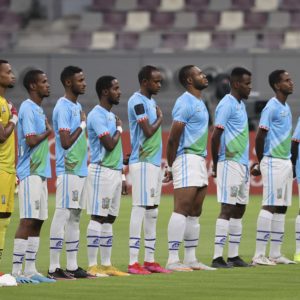Football keeps floundering in East Africa
The region produces star athletes in other sporting codes, but footballers are hurt by weak management, poor infrastructure and little incentive to stay.
Author:
29 September 2021

In 1934, Egypt became the first African country to send a team to the Fifa World Cup held in Italy that year. Nearly 90 years later, of all five regions on the continent, only East Africa is yet to produce a representative to this grandest stage of international football. So what has its countries failed to do or done wrong over the years, and can any of them get their act together to make it to Qatar 2022?
In other codes, especially athletics, several East Africans have reached the pinnacle of their sport. Uganda’s Joshua Cheptegei and Ethiopia’s Almaz Ayana own the men’s and women’s 10 000m world records, respectively, while Kenya’s David Rudisha holds the world record in the men’s 800m.
Eliud Kipchoge, the first man to run a full marathon in under two hours, albeit unofficially, comes from Kenya and is considered one of the greatest marathoners of all time.
Related article:
The Uganda women’s netball team are two-time African champions and participated in the World Netball World Cup and Commonwealth Games. Kenya’s women’s volleyball outfit, the Malkia Strikers, are a record nine-time African champions, with several Olympic Games and FIVB World Championship appearances to boot.
Kenya and Uganda continue to challenge southern Africa in rugby sevens, even though the gap between them and powerhouse South Africa is still glaringly wide in 15-man rugby. Kenya has even qualified and reached the semifinals of the ICC Men’s Cricket World Cup. It all goes to show the sporting potential in East Africa.
But then comes football.
Out of reach
There are 11 teams in the central-east zone of the Confederation of African Football: Burundi, Djibouti, Eritrea, Ethiopia, Kenya, Rwanda, Somalia, South Sudan, Sudan, Tanzania and Uganda. The ultimate glory of football, which is to play at the World Cup, has remained a mirage for these teams. And that is despite the sport being the region’s most followed.
One of the reasons is the lack of a discernible style of football in East Africa. Regular World Cup participants and winners such as Brazil, Italy and Germany all have a unique brand of play that easily identifies them. Brazil’s “ginga”, for example, is a style of elegance and flair that is widely revered and recognised.
The same can be said about regular African qualifiers like Egypt, Morocco, Tunisia, Nigeria and Cameroon. The ball moves much faster and is played with flair in the north, while in West and Central Africa it is often about impact play with individual strengths added.
Related article:
But there is no such thing as a brand in either East Africa as a region or in its individual countries.
“The foundation is wrong,” says veteran Kenyan sports journalist Daniel Wahome. “There’s no philosophy on how football is played in Kenya and the region at large.”
Wahome also says football in East Africa needs more investment in infrastructure and human resources if it wants to grow and improve. “How many coaches from this region are qualified to handle continental games?”
Quality players
For Milutin “Micho” Sredojevic, who has spent more than a decade in East Africa coaching in Ethiopia, Rwanda and Uganda, and did short stints in southern and North Africa, it is more about getting top-flight players with international experience. The Serbian coach faces charges of sexual assault in Gqeberha and left Orlando Pirates in a huff following accusations of indecently exposing himself to a hotel staffer where the club camped in Johannesburg.
“It’s simple and tactical,” he says. “The last team without high-profile players to qualify for the World Cup was Togo in 2006. They had [only] one superstar in Emmanuel Adebayor and the rest of the team followed him and they went to the World Cup.
“However, after that, the criteria and standards are very simple: you need to have an extremely strong league, or [be in a situation] like Egypt, for example, that has many players playing in the top five leagues in Europe.”
East Africa hardly ever exports talent to the top European leagues, notably those in Germany, Italy, England and France. One theory advanced to explain this is global scouts’ poor attitude towards the region, which they see strictly as a haven for runners.
Related article:
In the past decade or so, just three players from the region have made it to these leagues. Kenya produced McDonald Mariga, who won the European Champions League with Inter Milan of Italy, and his younger sibling Victor Wanyama, who featured for English sides Southampton and Tottenham Hotspur. From Tanzania came Mbwana Samatta, who barely lasted at Aston Villa and eventually moved to Turkey.
Without good players, Sredojevic says that going to the World Cup will remain “a tall mountain to climb” for East African teams.
“We shall, however, never give up, and we shall try our best and we’re looking to stretch our limits,” says the man famed for breaking Uganda’s nearly four-decades-long wait to return to the Africa Cup of Nations (Afcon) in 2017.
Years of work
Musa Otieno, 47, the most capped player of Kenya’s Harambee Stars and their former assistant coach, says the region’s Achilles Heel is poor preparation and a lack of business sense.
“Some [other] teams planned for Qatar 2022 qualifiers five years ago, so it’s just a matter of good planning. With good planning anything is possible.”
Otieno says with most domestic leagues in the region still being amateur or semi-professional, identifying and nurturing talent is never a structured process and talented players often go to waste. The business side of the game is hardly understood and sponsors shy away from football.
Related article:
“We still play for a hobby,” says Otieno. “We need to take football as business. That way, the region will be able to churn out enough talent that can gain experience in the best leagues in Europe and come back to help their national teams.”
Otieno is also concerned that East African teams seldom maximise home ground advantage in their qualification campaigns. This is already evident two rounds into the Qatar 2022 qualifiers, with only Ethiopia and Tanzania picking up home wins while Uganda, Rwanda and Kenya settled for draws.
“We need to dominate home matches because playing away in Africa is always tricky,” he says.
A word of warning
East Africa should learn the hard lessons from other regions on the continent and invest in football. Cameroon, the African team with the most World Cup appearances at seven, missed the last showpiece in Russia owing to the falling standards of the game in the West African country.
According to Cameroonian journalist Daniel Ekonde, the domestic league is so poorly managed that talent isn’t identified. This has a direct influence on the national team’s performance.
“The 1990 World Cup squad that reached the quarterfinals in Italy had around 11 Cameroon-based players,” says Ekonde. But since then, promising players have left as soon as they could.
“Our national football is not well funded and so players barely stay for one or two seasons before they prematurely leave for the Middle East and North Africa for greener pastures,” says Ekonde. “They don’t really have the opportunities the likes of Samuel Eto’o and Alexandre Song enjoyed. The players matured in Cameroon before they left for elite leagues in Europe.”
Previously, Cameroon’s top-division clubs were among the preferred destinations for talent from across Africa. Canon Yaoundé, now wallowing in the lower divisions, dominated CAF interclubs and helped shape the country’s rich football history.
Related article:
Tonnerre Yaoundé was home to luminaries like Roger Milla, the hero of the 1990 World Cup for not only Cameroon, but Africa at large, and Rigobert Song, the record holder for the most Afcon appearances and one of Africa’s finest defenders ever.
“You now see Cameroon players go to play football in Equatorial Guinea, Kenya, Nigeria, Tanzania… The reverse was true in the past,” says Ekonde.
In the past few years, club football has witnessed some growth in East Africa, albeit negligible. The Tanzanian league is showing positive signs and getting players and coaches from across Africa. This has had a positive impact on the national team, the Taifa Stars, who qualified for the 2019 Afcon after a painfully long wait.
To qualify for the World Cup, however, this growth will have to be sustained in order to deliver enough world-class talent with enough experience to challenge the big boys of African football. Otherwise, as Sredojevic puts it, it will take a “miracle of biblical proportions” for an East African team to grace the World Cup stage.





